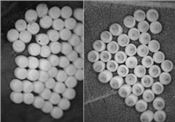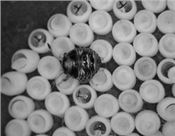|
Stink Bug Populations Surpassing Economic Thresholds In Soybeans In 2020
DR. RAUL T. VILLANUEVA AND DR. ZENAIDA VILORIA
PRINCETON, KY.
Several stink bug (Hemiptera: Pentatomidae) species (Figure 1) are key pests of soybeans in Kentucky. They include the green stink bug (Chinavia hilaris), brown stink bug (Euschistus spp.), southern green stink bug (Nezara viridula), brown marmorated stink bug (Halymorpha halys) and red shouldered stink bug (Thyanta custator). This group of insects is especially damaging during the late part of development of soybeans. Adult and immature stink bug stages feed by piercing tender terminals and developing pods causing direct damage to beans. These injuries may cause poor seed formation, aborted seeds, reduced seed size, or seed deformation. Therefore, it reduces yield and quality of beans.
I noticed abundant number of stink bug egg-masses (Figures 2) while conducting studies and scouting for insects in soybean fields during mid-August. Later, first nymphal stages were observed (Figures 1 and 3), and during the first and second weeks of September, all immature stages and adults were tallied across thirteen commercial soybean fields in seven Kentucky counties (Caldwell, Christian, Crittenden, Daviess, Henderson, Lyon, McLean, Ohio, and Trigg), and three research plots at the University of Kentucky Research and Education Center (REC) in Princeton.
Compared with previous years, it seems that 2020 is a ‘great year for stink bugs.’ Tallies of stink bugs conducted in six Kentucky counties (McLean, Henderson, Daviess, Ohio, Cadwell, Lyon and Crittenden) present a picture of this situation. In only three commercial soybean fields (Caldwell, Christian, and Ohio counties) the numbers of stink bugs were below the economic threshholds of 9 stink bugs for the R1-R3 development stages or 36 stink bugs for R4-R6 per 100 sweeps (Figure 4). In addition, in nine out of thriteen locations, the numbers tallied were considerablely high (above 20 stink bugs/100 sweeps).
Some of the sites surveyed had double-crop soybeans (beans that were planted after wheat) and the pods were not fully developed compared with full-season soybean fields; thus, these fields showed the lowest numbers of stink bug tallies (less than or equal to 3 stink bugs/100 sweeps) (Figure 4). This situation occurred even when the fields were contiguous, such as two contiguous research plots at the University with 68.0±12.1 and 3.0±1.2 stink bugs/100 sweeps (Figure 5). However, double-crop soybean fields are not necessarily free of stink bugs, because as beans mature and the full season soybeans are harvested, stink bugs will move to these sites.
Management
Scouting
Scouting for stink bugs is one of the most important tools for their management. Although beat cloths were recommended in the past as a tool for tallying insects, current narrower rows and higher plant densities make those difficult to use. Sweep netting is now the preferred method for tallying stink bugs.
Insecticides
An application of insecticides is recommended if stink bug tallies are above the economic threshold (36 bugs/100 sweeps). Pyrethroids or other mode of action insecticides can be used to reduce stink bug populations. ∆
DR. RAUL VILLANUEVA: Extension Entomologist, University of Kentucky
DR. ZENAIDA VILORIA: Entomology Research Analyst, University of Kentucky

Figure 1. Nymphal stages of the brown marmorated (left), green
center), and brown (right) stink bugs.
Photos: Raul T. Villanueva, UK

Figure 2. Egg masses of green stink bugs; mature eggs change color
before hatching (right).

Figure 3. First nymphal stage of green stink bug (Chinavia hilaris)
and hatched eggs.

Figure 4. Mean (±SEM) numbers of stink bug tallies conducted during the first and second weeks of September 2020 in thirteen commercial soybean fields in nine KY counties. Economic threshold of 9 and 36 stink bugs per 100 sweeps for R1-R3 and R-4-R6 development stages, respectively, shown by red dashed line.

Figure 5. View of full season (left) and double crop (right) soybeans planted contiguously. Depending on the bean
maturity stage, stink bugs will colonize fields with more mature beans.
|
|